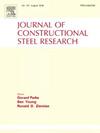Behavior of GRAC-filled square steel tubular stub column under axial compression
IF 4
2区 工程技术
Q1 CONSTRUCTION & BUILDING TECHNOLOGY
引用次数: 0
Abstract
Geopolymer recycled aggregate concrete-filled steel tube (GRACFST) is a low-carbon and sustainable structural form. This paper conducted an experimental study on the mechanical behavior of square GRACFST stub columns under axial compression through twenty-two specimens' tests. The concrete type, strength grade, RA substitute rate, and steel tube thickness were considered as the main variables. The results indicated that the major failure mode of the columns is bulking failure, yet it can be alleviated by increasing RA substitute rates and steel tube thicknesses. Compared with cement-based RACFST, using geopolymer concrete leads to higher ultimate strength and initial stiffness of GRACFST, but lower ductility. While, the changing rule for the addition of RA is just on the contrary, with showing reduced ultimate load but improved ductility. The maximum reducing amplitude for ultimate load of GRACFST column is 16.34 %. Moreover, the thicker steel tube greatly enhances the ultimate load, stiffness and post-peak ductility, exhibiting prominent confinement effect on the core GRAC, which is insensitive to the concrete strength and RA substitute rate, but binder type. In addition, codes based on unified theory can provide accurate predictions for the ultimate resistance, and a simplified empirical calculation formula was developed based on test results. Furthermore, a theoretical calculation method using the multi-axial strength criteria of GRAC was proposed with showing improved prediction accuracy for the ultimate load-bearing capacity of GRACFST stub columns.
求助全文
约1分钟内获得全文
求助全文
来源期刊

Journal of Constructional Steel Research
工程技术-工程:土木
CiteScore
7.90
自引率
19.50%
发文量
550
审稿时长
46 days
期刊介绍:
The Journal of Constructional Steel Research provides an international forum for the presentation and discussion of the latest developments in structural steel research and their applications. It is aimed not only at researchers but also at those likely to be most affected by research results, i.e. designers and fabricators. Original papers of a high standard dealing with all aspects of steel research including theoretical and experimental research on elements, assemblages, connection and material properties are considered for publication.
 求助内容:
求助内容: 应助结果提醒方式:
应助结果提醒方式:


